15 Java Frameworks That Will Boost Your Development in 2023
Java is a programming language used to develop web and desktop-based applications. Furthermore, many Java frameworks have been developed over the years to make the development process easier and faster. Consequently, these frameworks provide tools and libraries for developers to build web applications more efficiently.
As a result, this blog will delve into 15 Java frameworks that will significantly boost your development in 2023.
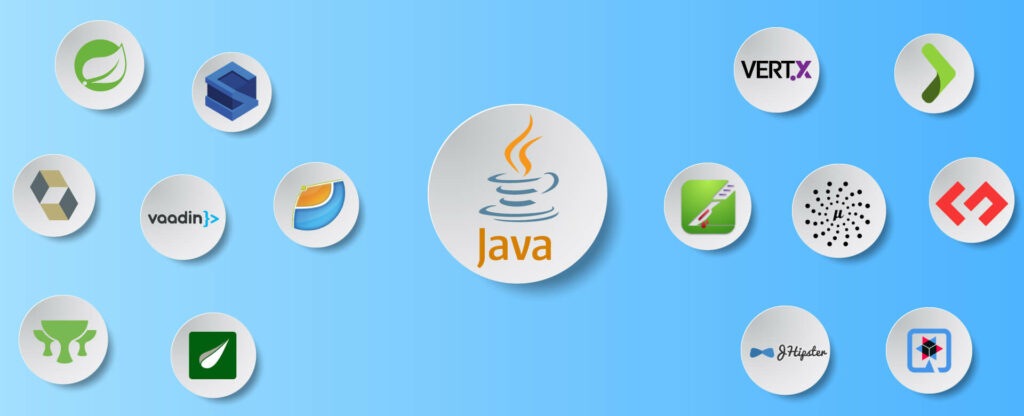
Importance of Java frameworks in development:
Java frameworks provide a structured and organized approach to application development. Moreover, they offer pre-built modules, libraries, and tools that simplify and expedite development.
Additionally, by utilizing external dependencies such as JJWT, frameworks can be configured to enhance the application’s security. Furthermore, they contribute to enhancing the scalability and performance of the application.Moreover, given that Java is a verbose language, developers can efficiently bypass writing boilerplate code by leveraging the appropriate frameworks based on their specific requirements.
1. Spring Framework:

Spring is one of the most used Java frameworks. It offers a comprehensive programming and configuration model for modern JEE applications. It comes with features, such as DI, AOP, and data access, that makes it a preferred choice for developers.
Pros:
- Firstly, AOP enables the creation of Aspects for crosscutting concerns.
- Additionally, it is easy to integrate with other frameworks.
- Moreover, adding configuration for beans with the Application context is easy.
- Furthermore, it provides support for ORM frameworks to manage DB.
Cons:
- Spring has covered many aspects required for developing EE applications which tends to be tough to learn about it.
There are different ways; one can do the spring configuration, making it complex initially.
2. Hibernate:

Hibernate is an ORM framework for Java. Moreover, it simplifies the process of mapping Java objects to databases. Additionally, Hibernate is an excellent choice for web app development due to its features like automatic table creation, data retrieval, and caching.
Pros:
- Simplifies database programming by providing standard configuration
- Offers high performance by handling internal sessions with DB
- Excellent support for SQL queries
Cons:
- Requires a good understanding of database concepts
- This can lead to complex queries, as we may need to write them down manually
- Debugging can be difficult for Hibernate
3. Apache Struts:
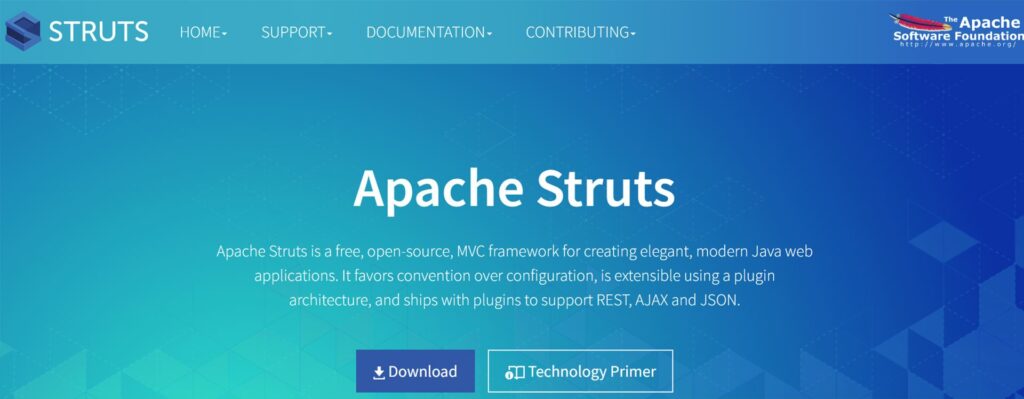
Apache Struts is an MVC-based framework used for developing web applications. Moreover, it includes a set of libraries and tools that aid in creating scalable and maintainable web applications.
Pros:
- Struts follow the Model-View-Controller (MVC) architectural pattern
- Struts have a rich ecosystem with a wide range of plugins and extensions available
- Good documentation about dependency management and configuration
Cons:
- Struts have a steeper learning curve compared to some other frameworks
- Struts heavily rely on XML configuration files, which can be lengthy and complex
- Struts may not have some of the modern features and capabilities found in newer frameworks
4. JavaServer Faces (JSF):

The JSF framework, in addition to that, assists in constructing user interfaces for web applications. Moreover, it provides a range of pre-built UI components that can be effectively utilized to create interactive and user-friendly interfaces.
Pros:
- Support for component-based architecture for easy web development
- It uses JSTL for the dynamic binding of the Java objects
Cons:
- Lead to complex configuration files for resource management
- Performance issues with large applications
5. Play Framework:

The Play framework, a lightweight web framework, supports Java and Scala. Moreover, its simple and intuitive programming model greatly assists developers in rapid web application development. Furthermore, it is well-suited for reactive web applications requiring high concurrency and low latency.
Pros:
- Suitable for building scalable and responsive web applications
- The play has a lightweight architecture and convention-over-configuration approach
- Provides good documentation for implementation
Cons:
- The play has minimal community support
- Limited compatibility with other frameworks
6. Vaadin:
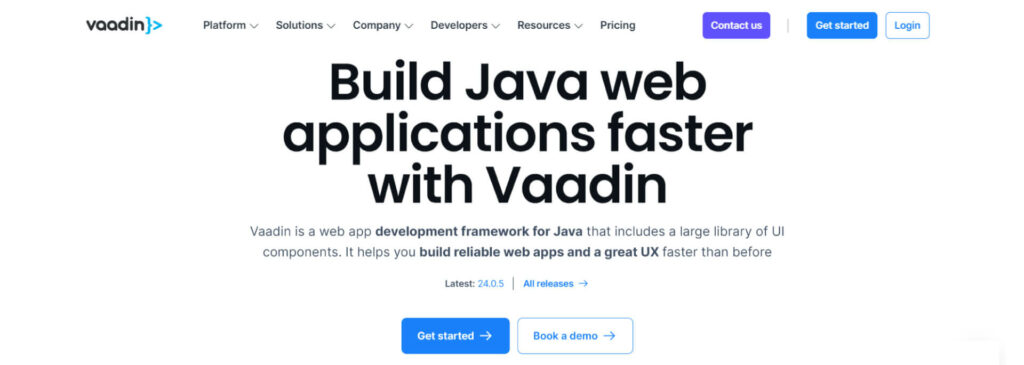
Furthermore, in the realm of business-oriented web applications, Vaadin serves as the preferred choice. Notably, Vaadin offers a comprehensive collection of pre-built UI components, facilitating the development of interactive and user-friendly applications.
Pros:
- Provides a complete set of UI components for web applications
- Easy to learn and use with the help of documentation
- Supports cross-platform compatibility
Cons:
- Vaadin’s configuration is complex to do, which makes it hard to implement
- Due to limited community support, Vaadin has become less popular nowadays
- It has limited third-party integrations
7. Vert.x:
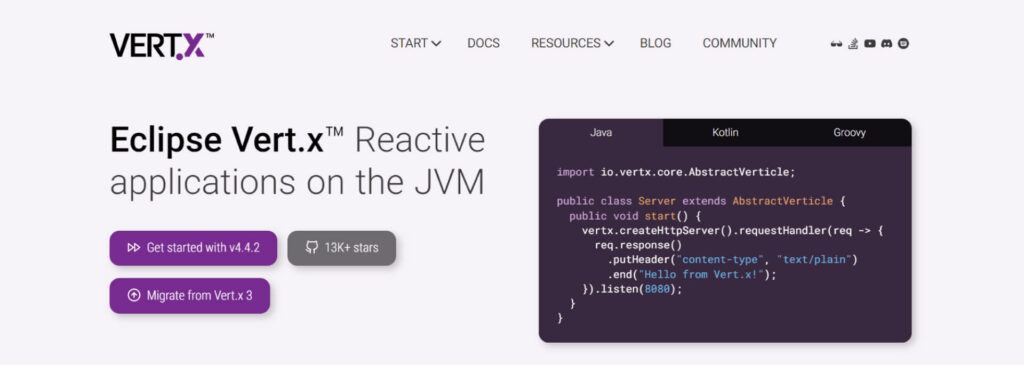
Vert.x is an open-source framework. It is also a lightweight, high-performance framework focusing on event-driven development. As a result, it is suitable for building reactive systems.
Vert.x is polyglot, which means it can be used with other JVM languages such as Kotlin and Groovy.
Pros:
- It supports multiple languages
- It has a reactive programming model
- Built-in clustering and scaling
Cons:
- Vert.x has a bit tough to understand at the beginning
- It has a lack of tooling
8. JHipster:

JHipster is an open-source development platform for modern web applications and microservices. Moreover, it is built upon Spring Boot and Angular, which provides a powerful combination of backend and frontend frameworks. JHipster also includes a powerful code generator, enabling developers to scaffold new projects and quickly generate CRUD code.
Pros:
- JHipster’s code generator helps to scaffold new projects and generate standard code quickly
- It has many resources available for learning and troubleshooting
Cons:
- JHipster is a complex framework that can be overwhelming for less experienced developers
- Code generation may not be suitable for a high degree of customization applications
9. Micronaut:
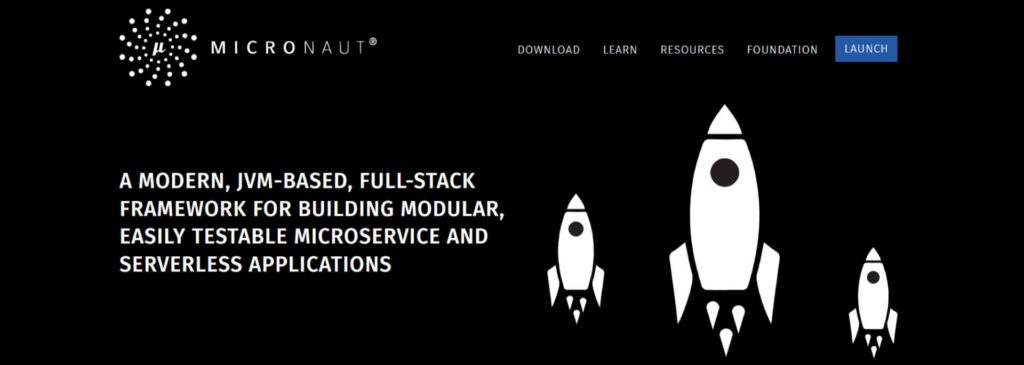
Mirconaut is used for building microservices and serverless applications. Additionally, it is a lightweight, modular, and fast Java-based framework. In addition to that, it is perfectly designed for cloud environments such as AWS lambda and Kubernetes.
Pros:
- Micronaut is a modular framework that allows developers only to include the dependencies that are needed
- Built-in features such as caching, security, and reactive programming
- Micronaut has a large active community
Cons:
- Micronaut has a unique architecture and syntax, which make the learning curve for new developers
- It may have fewer third-party libraries and integrations available
10. Quarkus:
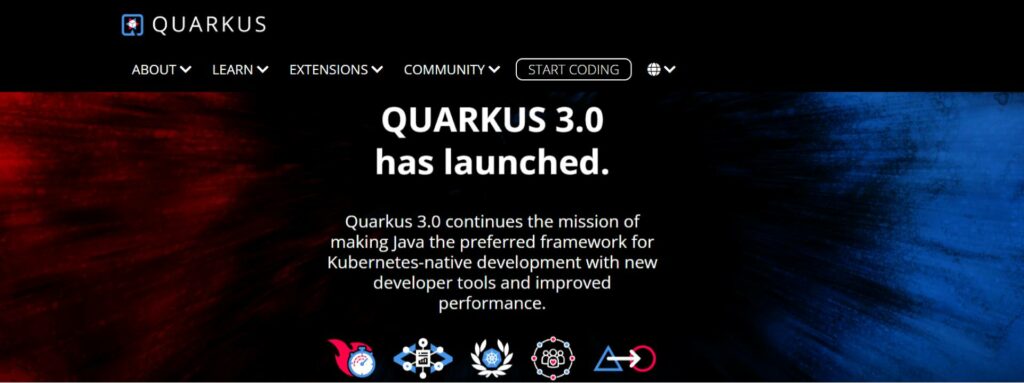
Quarkus is a modern, cloud-native, and open-source Java framework. Furthermore, it is specifically designed for highly performant and scalable applications. In addition, it stands out as an ideal choice for Kubernetes containers due to its fast startup. Moreover, Quarkus leverages GraalVM’s native image technology, resulting in high-speed startup and low memory usage.
Pros:
- It has a fast startup time and a low memory footprint
- Quarkus leverages GraalVM’s native image technology
Cons:
- Quarkus is a relatively new framework as compared to Spring and others
- Quarkus has a more miniature ecosystem
- Its native image compilation is a bit challenging
11. Google Web Toolkit (GWT):
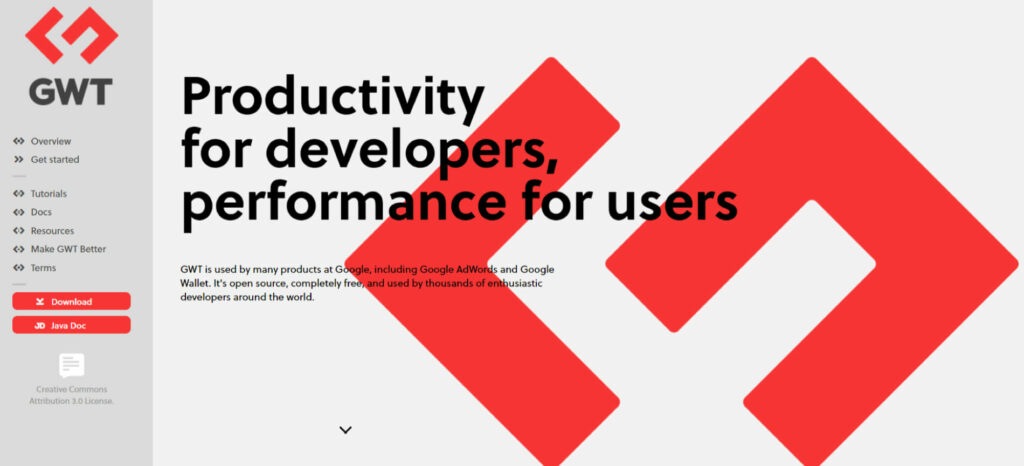
GWT is a free, open-source framework for building web applications using Java code. It allows developers to write client-side web applications in Java, which is then compiled into optimized JavaScript code.
Pros:
- It is built for high-performance applications
- Debugging and testing tools are easy in GWT
- It supports cross-browser compatibility
Cons:
- GWT has limited third-party libraries
- GWT has limited design and layout options
12. Thymeleaf:
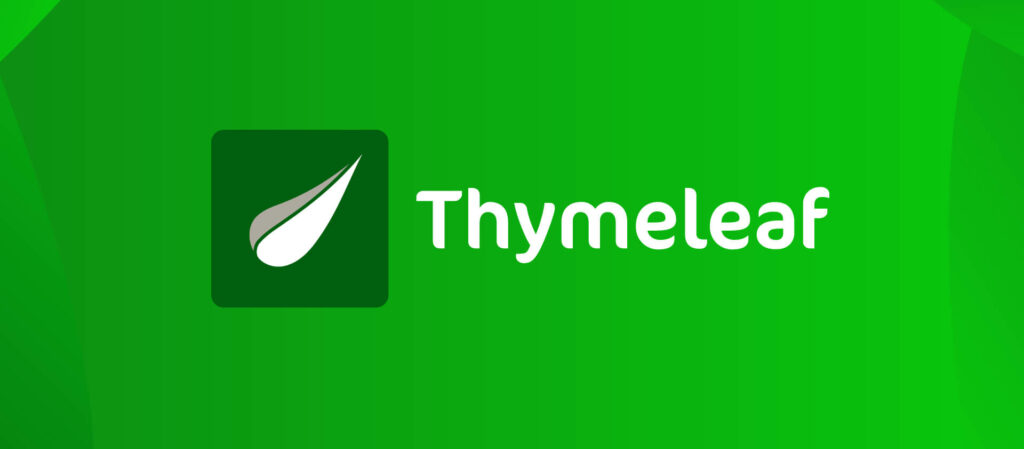
Thymeleaf, a Java-based template engine, creates dynamic web pages. Moreover, it allows developers to write HTML templates and incorporate dynamic content using Java code. Additionally, Thymeleaf boasts a natural template syntax, which ensures ease of readability and writing.
Pros:
- Its Natural template syntax makes it easy to development
- Server-side rendering boots development and client-side rendering
Cons:
- Thymeleaf has limited third-party library support
- It does not support client-side rendering
13. Eclipse Vert.x:
Eclipse Vert.x is a lightweight, event-driven, non-blocking, multilingual framework for building reactive applications. Additionally, it supports multiple programming languages, such as Java, Kotlin, and JavaScript. Moreover, Eclipse Vert.x provides a toolkit for building high-performance, distributed systems with minimal resource consumption.
Pros:
- It is built for high-performance and polyglot applications
- It supports reactive programming
Cons:
- It has limited the availability of third-party libraries and tools
- No build in ORM which makes it tough to manage DB
14. Grails:
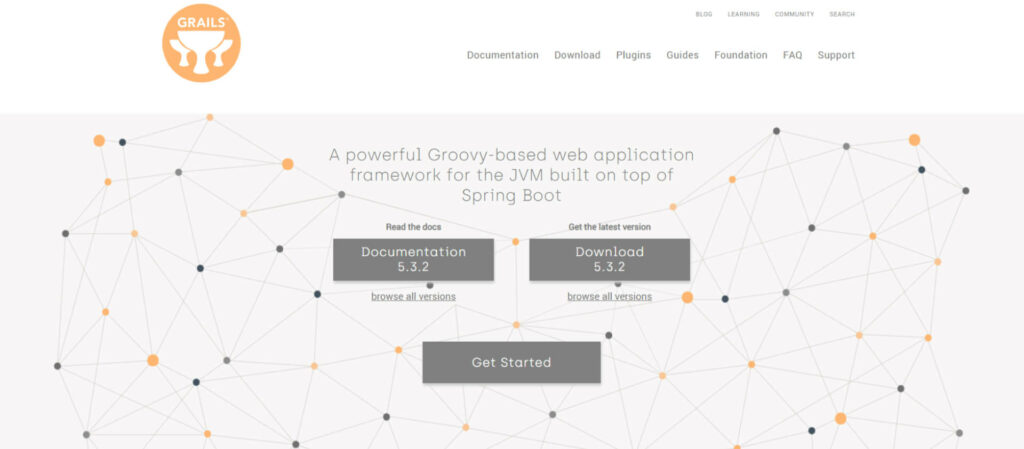
Grails, a JVM-based, open-source web framework, utilizes Groovy for full-stack development. Moreover, it is designed to be highly productive and user-friendly, thanks to its convention-over-configuration approach.
Pros:
- Grails are very easy to integration
- It supports the plugin ecosystem
Cons:
- It has limited flexibility as compared to other
- It is not compatible with many 3rd party integrations
15. Blade:
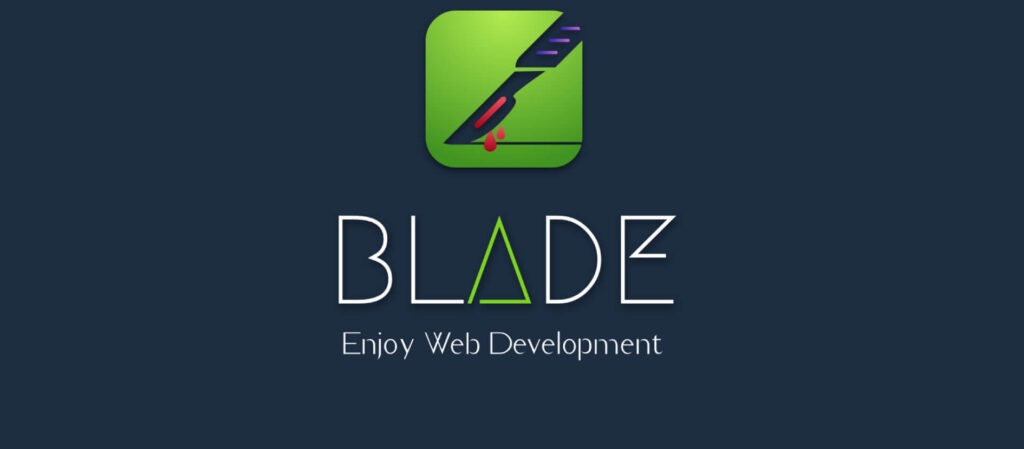
The Blade is a lightweight, high-performance web framework for Java and Kotlin. Additionally, this framework follows MVC architectural patterns. Moreover, it is designed to be simple and easy to use, adopting a minimalistic approach to development.
The Blade comes with built-in support for features such as routing, middleware, and templates.
Pros:
- The Blade is designed to be lightweight and fast
- Due to good documentation, Blade is simple and easy to use
Cons:
- The Blade has limited scalability
- It has a lack of enterprise support
Conclusion
In conclusion, Java offers a variety of frameworks, each with unique strengths and weaknesses, for developers to explore.
Spring is trendy and widely used, offering extensive tools and modules for complex app development. Hibernate makes database access simple. Struts provide a solid foundation for building web applications, while other frameworks like Micronaut and Quarkus offer lightweight and fast alternatives over other ones.
Choosing the proper Java framework for your project:
When choosing the proper Java framework, there are several important factors to consider:
1. Project requirements: Understanding project requirements, like app size, complexity, database, and traffic, is crucial.
2. Community support: A strong and active community is essential to choosing a framework. This includes easy access to documentation, tutorials, and community forums where developers can ask questions and get help.
3. Scalability: Frameworks should be able to handle increasing traffic and data loads without sacrificing performance or stability.
4. Integration with other tools: Seamless integration with build tools, testing frameworks, and IDEs is essential for a framework.
5. Security: Built-in security features, like authentication and authorization, are crucial for a framework.
Unlock the potential of your software solutions with Thinkitive’s Java development services. Hire Java developers through our free trial and take your projects toward excellence.




